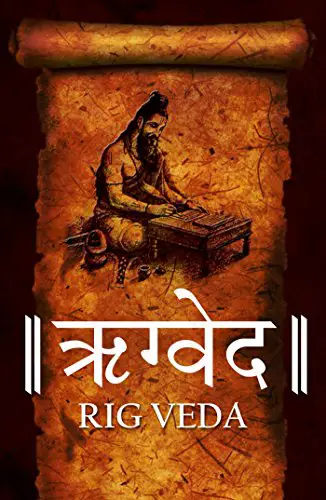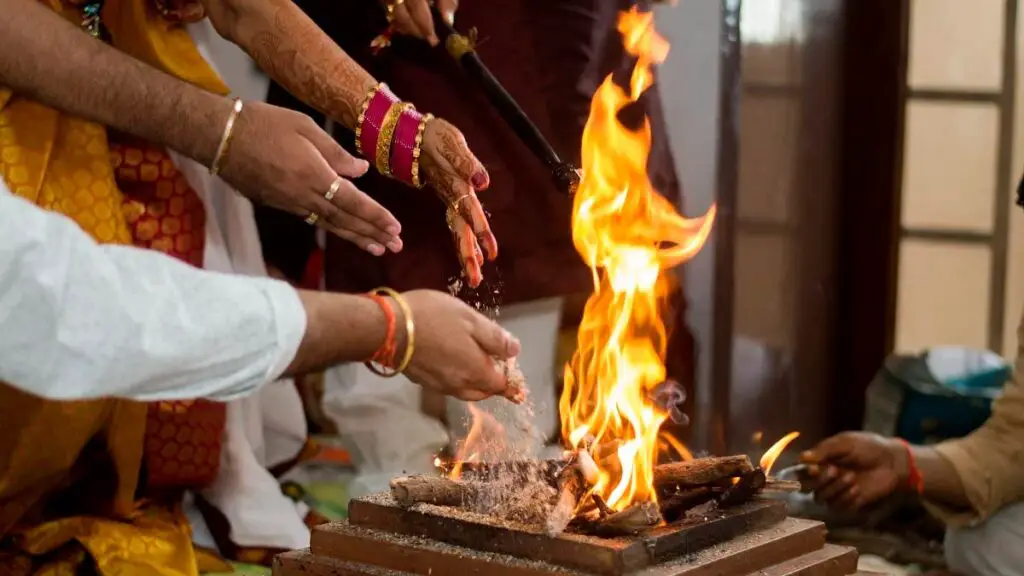Hare Krishna guys. As we know the oldest Hindu book is RIG VEDA which is written in Ancient Sanskrit language. If we translate meaning of Rig Veda it will be “The Knowledge of Verses“. Rig Veda consist of hymns to pray various gods, it has total 10 mandalas and 1028 hymns. As they are written in Sanskrit most of us are unable to extract the knowledge in it. But don’t worry we will translate all of Rig Veda Hymns in simple and understandable english. In this article we will learn about the First Sukta or Hymn of First Mandala. So let start by saying ” Jay Shree Krishna”

The First Hymn is addressed to God AGNI, The writer is Rishi Madhuchhandas, son of Vishwamitra, The metre of these Hymns is Gayatri.
अग्निमीळे पुरोहितं यज्ञस्य देवं रत्वीजम |
होतारं रत्नधातमम ||
aghnimīḷe purohitaṃ yajñasya devaṃ ṛtvījam |
hotāraṃ ratnadhātamam ||
I glorify the Agni,The high priest of the Scrifice(Yajnas), the divine, the ministrant, who presents oblation to the gods and possessor of great wealth.
अग्निः पूर्वेभिर्र्षिभिरीड्यो नूतनैरुत |
स देवानेह वक्षति ||
aghniḥ pūrvebhirṛṣibhirīḍyo nūtanairuta |
sa devāneha vakṣati ||
May the Agni who has been glorified by the Ancient and as well as by the Modern sages also bring the gods to this Yajna(Scrifice).
अग्निना रयिमश्नवत पोषमेव दिवे-दिवे |
यशसं वीरवत्तमम ||
aghninā rayimaśnavat poṣameva dive-dive |
yaśasaṃ vīravattamam ||
Through worshiping of Agni the Worshipper gains affluence and by the blessing of Agni it increases day by day , which is the source of fame and the multiplier of mankind.
अग्ने यं यज्ञमध्वरं विश्वतः परिभूरसि |
स इद्देवेषु गछति ||
aghne yaṃ yajñamadhvaraṃ viśvataḥ paribhūrasi |
sa iddeveṣu ghachati ||
Hey Agni, The Yajna which you protect from every side, surely reaches the god to please them.
अग्निर्होता कविक्रतुः सत्यश्चित्रश्रवस्तमः |
देवो देवेभिरा गमत ||
aghnirhotā kavikratuḥ satyaścitraśravastamaḥ |
devo devebhirā ghamat ||
Hey Agni, the presenter of oblations, the attainer of knowledge, he who is true, renowned and divine, please come here with the other gods to this Yajna.
यदङग दाशुषे तवमग्ने भद्रं करिष्यसि |
तवेत तत सत्यमङगिरः ||
yadaṅgha dāśuṣe tvamaghne bhadraṃ kariṣyasi |
tavet tat satyamaṅghiraḥ ||
Hey Agni, whatever good blessings you give upon the giver of the oblation, that verily revert to your glory itself.
उप तवाग्ने दिवे-दिवे दोषावस्तर्धिया वयम |
नमो भरन्त एमसि ||
upa tvāghne dive-dive doṣāvastardhiyā vayam |
namo bharanta emasi ||
Hey Agni, we pray to you with reverential homage in our thoughts, daily from morning to evening.

राजन्तमध्वराणां गोपां रतस्य दीदिविम |
वर्धमानंस्वे दमे ||
rājantamadhvarāṇāṃ ghopāṃ ṛtasya dīdivim |
vardhamānaṃsve dame ||
Hey Agni, the radiant, the protector of the Yajnas, the constant reflector of truth, increasing in thine own dwelling.
स नः पितेव सूनवे.अग्ने सूपायनो भव |
सचस्वा नः सवस्तये ||
sa naḥ piteva sūnave.aghne sūpāyano bhava |
sacasvā naḥ svastaye ||
Hey Agni, be unto us easy of access, like a father to his son; always stay with us so that your blessings never gets away from us.
CONCLUSION:
In conclusion of the first sukta of rig veda we understood that, the invocation of Agni in daily prayers carries profound significance, symbolizing not just a ritualistic act but a deep connection to timeless truths and spiritual guidance. As the radiant guardian of Yajnas, Agni embodies the essence of protection and purification, ensuring the sanctity of our offerings and endeavors. Furthermore, Agni’s role as the constant reflector of truth underscores the importance of honesty and integrity in our lives.
In our supplications to Agni, we beseech not only for his blessings but for his perpetual presence in our lives. Just as a father nurtures and supports his children, we implore Agni to be readily accessible to us, offering guidance and protection in times of need. The desire for Agni’s continual presence reflects our yearning for spiritual illumination and the assurance of divine support throughout life’s journey.
Ultimately, the significance of Agni transcends mere ritualism; it encompasses a profound spiritual connection and a recognition of the eternal truths that govern our existence. As we invoke Agni’s name with reverence and devotion, we reaffirm our commitment to truth, righteousness, and the pursuit of inner fulfillment. May Agni’s eternal flame continue to illuminate our hearts and minds, guiding us towards a life of purpose and prosperity.
Read the Next Sukta-2
FAQ:
Who wrote Rig Veda?
Ved Vyasa
When was Rig Veda written?
Approx. between 1500 BCE To 1000 BCE
The author of this website is Mr. Subham bera from West Bengal in India. I have pursued BCA. I am a blogger, Digital marketer and programmer. From the last 3 year i am reading, following various hindu books like bhagavat geeta, ramayana, vedas , purans etc. As per my knowledge most of the hindus lack in knowledge about their own religion just because they cant read or understand Sanskrit language. So i decided to take this platform to share all hindu books in a their simple English translated version and to spread awareness among all the hindus who want to know about their own religion and feel proud about it. I am not a certified person to translate the books. All the translation will be made by me only just to gain knowledge, i doesn’t have any intension of hurting anyone’s religions belief. If anyone finds any error in my posts. i request you to notify me on my social media platforms. Thank you.
Simply want to say your article is as amazing. The clarity in your post is simply excellent and i could assume you are an expert on this subject. Fine with your permission allow me to grab your feed to keep up to date with forthcoming post. Thanks a million and please carry on the rewarding work.
zq2grw
Hi there, I found your website via Google while searching for a related topic, your web site came up, it looks good. I’ve bookmarked it in my google bookmarks.